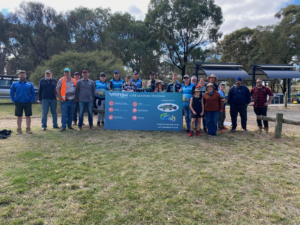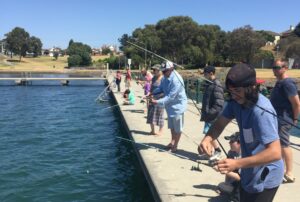October 3, 2016
By Shane Lowry
The Glenelg river in Victoria’s far southwest is a fishing paradise with a range of species available to target as well as stunning scenery and a diversity of habitat that supports both key angling species, smaller fish and a wide variety of wildlife.
Starting at Rocklands wall just above the township of Balmoral and stretching approximately 330km downstream to Nelson, the Glenelg River turns into a salt wedge estuary before finally emptying into the southern ocean.
Recently I was asked to take part in some fish survey work and angler engagement days conducted by the Glenelg Hopkins Catchment Management Authority with funding provided by the Victorian Environmental Water Holder. Both groups were on hand with representatives in attendance to discuss and receive any and all feedback from the general public.

The author with a lovely Glenelg River estuary perch
The angler engagement days were held over several weekends involving Angling Clubs, Community members and stakeholders of the river. The communities of Balmoral, Harrow, Casterton and Dartmoor all attended in fantastic numbers with the focus of these events being to engage directly with the management groups tasked with making decisions concerning the health of the river. In particular, the benefits of well-planned environmental flows and habitat improvement were key topics.
Although the Lower Glenelg National Park section of the river tends to remain in great condition all year round, the upper reaches of the river have suffered greatly over many years. Low flows have created a situation where the river becomes a series of individual pools with very little interconnectivity greatly deteriorating the health of the river in the warmer months.
The practices of environmental watering and habitat improvement in both the river and bankside riparian zones has become a very important ingredient in managing the river to ensure the best possible outcomes for not only the wildlife but also everyone who uses the Glenelg River, and it was extremely encouraging to see the willingness by all parties involved in the program to enter into a face to face dialogue.
The fish survey work involved the use of both electro fishing and the setting of Fyke nets (eel nets) to demonstrate these techniques to the general public but also to continue the ongoing work of surveying native species in the river and implementing control measures for non-native and invasive species such as European carp and Gambusia (mosquito fish). The electro fishing yielded great results on both fronts and it was amazing to find Estuary Perch in excess of 40cm just below Balmoral a distance of approximately 320km from the estuary. This is one of the longest recorded migrations of this species on record and simply would not be possible without the reconnection of the river brought about by environmental watering.

It was amazing to find an Estuary Perch in excess of 40cm just below Balmoral – a distance of approx 320km from the estuary.
We also encountered Australian bass in these upper reaches and although they are a non-endemic species to the Glenelg they were in good numbers and in very healthy condition with Bass in excess of 3kg captured and released. In my opinion, this represents an exciting and as yet untapped recreational fishing opportunity for the townships along the upper reaches of the river.
Measures are also being taken to control the population of European carp in the river. Fish exclusion screening pools at Rocklands Reservoir wall are ensuring there is no migration of Carp. The ‘Judas Carp’ program which involves acoustic tagging and tracking of individual fish has also been a very strategic move that exploits the natural behaviour of Carp to congregate. Coupled with the use of side imaging sonar, great success is being achieved in directly targeting large aggregations of Carp that can then be electro fished and removed from the system. This technique is providing excellent data on size, weight and numbers of fish revealing that
one main cohort of Carp exists in the river, further indicating that conditions and habitat are not ideal for them to breed successfully.
What we are now seeing on the Glenelg river is not only a focus by managers to improve overall river health but real recognition of the importance and value that all users can bring when engaged. We are in the midst of a generational change where stakeholders, in particular, recreational anglers are asking the “whys” and “how’s” and those involved in the management are more than willing to take onboard the opinions and answer the questions. This is a massive positive and means the Glenelg River has a bright and secure future.








